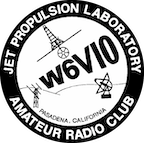By Bill Wood W6FXJ (May 1995 W6VIO Calling)
JPL’s Goldstone Amateur Radio Club first installed repeaters at the Table Mountain (TMO) Facility in 1977 and has supported their operation ever since. The JPL astronomy facility is located just northwest of Wrightwood, on the northern edge of the San Gabriel Mountains at 7500 feet in elevation.


Above, Table Mountain administration building. Right, 220MHz and 2-meter Antennas.
Here is a rundown on the three TMO repeaters: All are rack mounted in the telephone equipment closet of the administration building at Table Mountain. The repeater antennas are located on short utility poles on the northeast side of the building with an excellent view of the upper desert.
All the repeaters cover the upper desert from Frazier Park in the west, up through Fresno and Visalia in the central valley, across through Ridgecrest to Furnace Creek in Death Valley, on to Pahrump, Nevada, south to Mountain Pass and Ludlow, then further south to Yucca Valley. On the south side of the San Bernardino mountains the coverage runs from Banning in the east down through Hemet and back up to San Bernardino and up the Cajon pass. On the south side of the San Gabriel mountains the main coverage is inside a triangle from Azusa to Newport Beach, across to Manhattan Beach and back to Azusa.
The old 2-meter repeater, first installed in 1977, was replaced with a new more sensitive and powerful unit in August of 1994. It has a duplexer output power of 25 watts and a receiver sensitivity of 0.15 microvolts. It is equipped with a 131.8 Hz CTCSS (PL) decoder on the input that is required for maximum receiver sensitivity. For people not using the 131.8 Hz PL tone the squelch is set very tight to reduce interference from weak co-channel users. The repeater also uses a 131.8 Hz PL tone on the output to allow you to use “tone” squelch on your radio to keep out other repeaters on the same frequency. Currently there are five other repeaters coordinated on 145.28 in Southern California. These are located in Covina, Garden Grove, Santa Monica, Vista and Camarillo, listed in order of overlapping coverage with Table Mountain.
The 223.96 repeater was first installed in 1977. It uses an input CTCSS (PL) tone of 156.7 Hz, and can be connected to the JPL ARC WR6JPL 224.080 repeater in La Canada via a special link repeater installed at the City of Industry Sheriff’s station. The repeater has a duplexer power output of 45 watts and a receiver sensitivity of 0.15 microvolts. Table Mountain 220 is co-channeled with Mission Viejo in Orange County, Coronado in San Diego County, and Broadcast Peak in Santa Barbara County.
The original 447.325 MHz repeater was replaced in November of 1994 with a modified General Electric MASTR II radio and a very low-noise Angle-Linear GASFet preamplifier. These changes have significantly improved the performance. It has a duplexer power output of 25 watts and a receiver sensitivity of 0.12 microvolts. It is much more hand-held friendly and can be accessed from nearly everywhere that the 2-meter repeater can be used. A CTCSS (PL) tone of 94.8 Hz must be used. The output has a 94.8 PL as well to allow the use of tone squelch. Table Mountain 440 is co-channeled with Palm Springs, Fontana, Covina, West Los Angeles and Sulphur Mountain in Ventura County. If you are a 2-meter user with a dual-band radio, you might try the 447.325 repeater. It may offer a better alternative to the busy 2-meter machine.
To improve the operation of the Table Mountain repeaters, there have been a number of recent changes. In August of 1994 a number of repairs were required to fix damage caused by a nearby lightning strike. The original Super Stationmaster 2-meter antenna had to be replaced with a temporary Hustler G6-144. Later, in September of 1994, a new Palomar Telecom controller was added to allow a number of new functions to cross-link and control the three repeaters. Most recently a power amplifier was added to the 220 MHz repeater to improve circuit margins with the link repeater located in the City of Industry. On December 11, a 2-meter transmitter isolator was installed to reduce an intermod product that produces a low-level 144.685 Mhz signal when all three repeaters are transmitting. During the same visit a low-noise preamplifier was added to the 220 repeater to improve it’s sensitivity to 0.15 uv. In May or June of this year we expect to replace the temporary Hustler G6-144 2-meter antenna with a new Celwave Super Stationmaster unit to bring performance back to peak efficiency.
